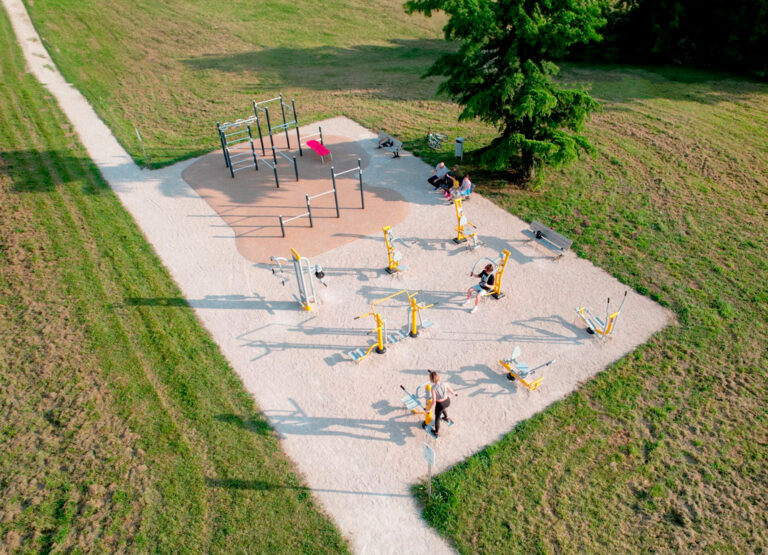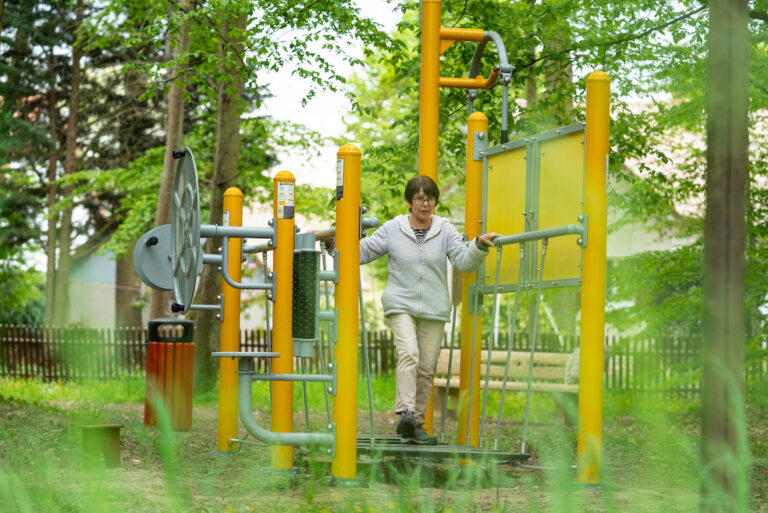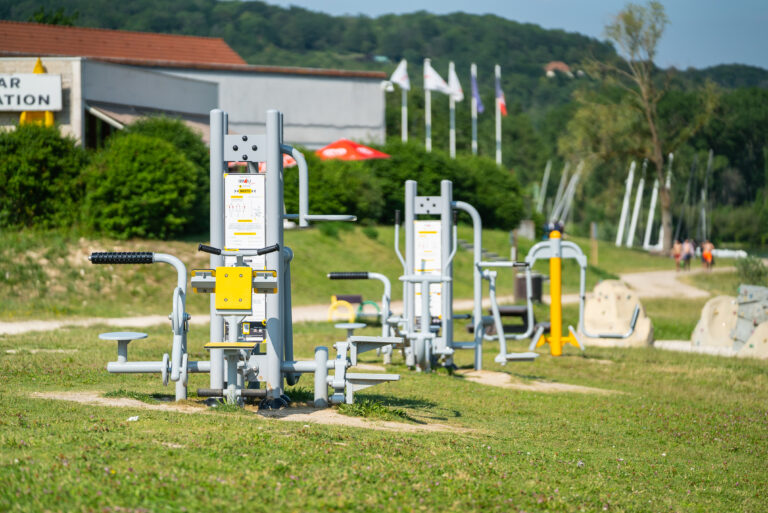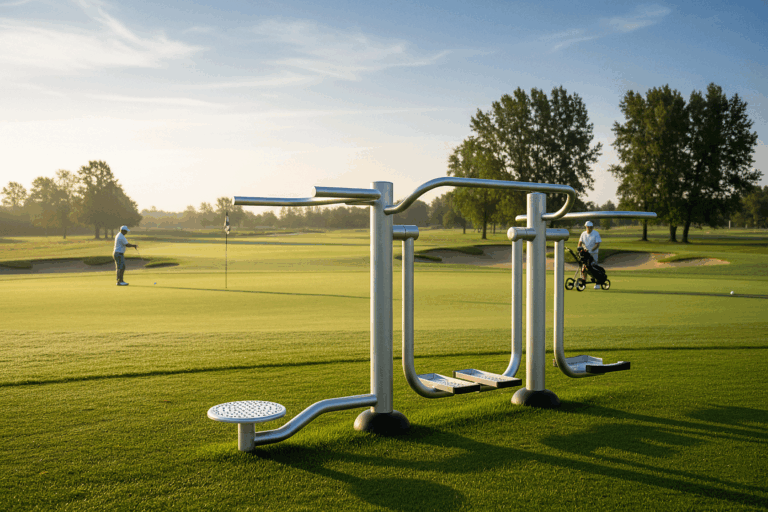Introduction
With the arrival of summer and rising temperatures, outdoor fitness remains a popular activity for its physical benefits, motivating environment and accessibility. But what to do when the heat becomes extreme? Increasingly frequent heatwaves pose a real question for fitness enthusiasts and local authorities alike: can we continue to train outdoors without taking risks?
The answer is yes, provided you adapt your habits. Exercising outdoors at 30 or 35 degrees Celsius can’t be improvised. To train safely, you need to know the right gestures, avoid certain common mistakes and listen to your body. The layout of public spaces also plays a key role: small adjustments can make a big difference to the comfort and safety of users.
This article gives you a complete overview of how to continue exercising outdoors during heatwaves, without putting your health at risk. From understanding the risks involved, to sessions designed specifically for hot weather, to the right equipment, find out how to combine physical activity with vigilance.
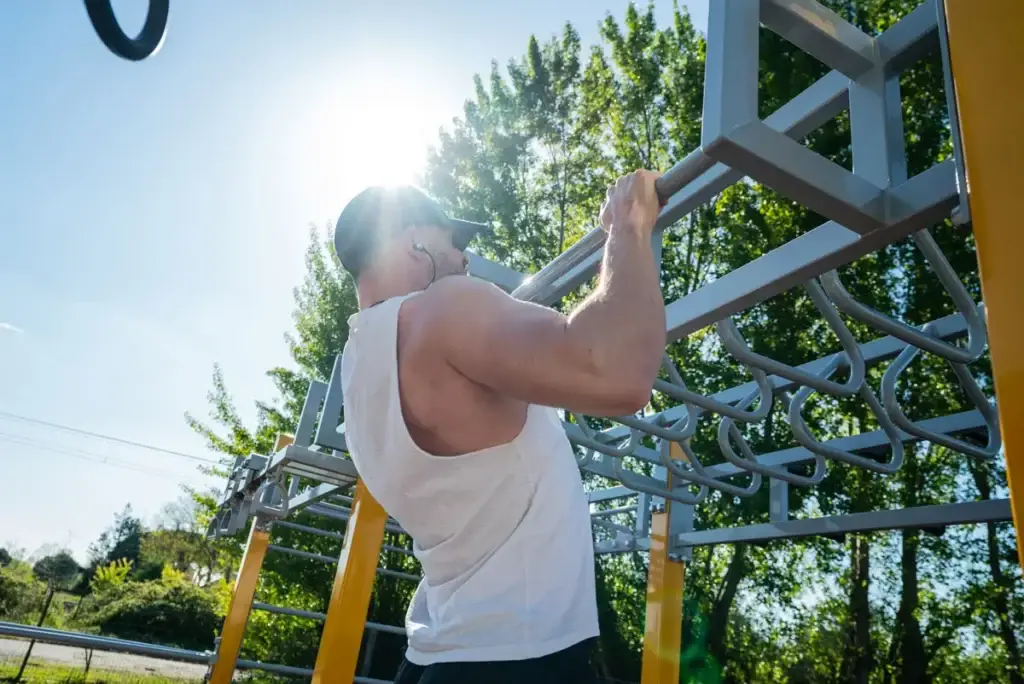
Why is safe training essential during a heatwave?
When temperatures exceed 30°C, and even more so during heatwaves, the human body has to redouble its efforts to maintain a stable internal temperature. During outdoor physical activity, this regulation becomes even more difficult: the body produces heat, sweats profusely and rapidly becomes dehydrated. It’s a dangerous circle which, if not properly anticipated, can jeopardize your health. In this context, safe training becomes an absolute priority.
The main danger is heat stroke. It occurs when the body’s natural cooling mechanism – perspiration – is no longer sufficient. Body temperature then rises rapidly, sometimes exceeding 40°C, with serious consequences: intense headaches, confusion, nausea, even loss of consciousness. Added to this is the risk of severe dehydration, affecting muscles, the nervous system and overall body function. Even a short session can become risky if you don’t take the right precautions to train safely.
Certain populations are particularly vulnerable: children, the elderly, beginners and those with chronic pathologies (cardiac, respiratory or metabolic). However, intense heat represents a risk for everyone, including experienced athletes. Prolonged exposure to the sun, without hydration or adaptation of intensity, can turn a beneficial session into a real danger.
Training safely during heatwaves means adapting your behavior. This requires a clear understanding of the risks, constant vigilance, and well-considered choices in terms of time, place and type of physical effort.
The right reflexes for safe training during heatwaves
When faced with intense heat, it’s not simply a question of reducing the duration of your session. To train safely during a heatwave, a number of adjustments are essential, whether you’re an occasional or a regular exerciser. These simple reflexes will help you avoid heatstroke, dehydration and fatigue-related injuries.
The first essential reflex is to choose the right times. We strongly advise against training between 11 a.m. and 5 p.m., when the sun’s rays are at their strongest. To train in complete safety, it’s best to train in the early hours of the day, before 10 a.m., or in the late evening, after 7 p.m., when the temperature begins to drop.
Where you train is also important. Training in a shaded, ventilated environment, or near a water source, helps to limit body overheating. A wooded area, a partially covered field or even a well-treed park offer far more favourable conditions for continuing to train in complete safety.
Personal equipment should not be neglected. Wearing light, breathable, light-colored clothing helps dissipate heat. A cap and sunglasses can also be useful for protection against direct radiation. This type of clothing is a simple but effective ally for safe outdoor training.
Hydration is a fundamental pillar. Drinking water regularly, before, during and after exercise, helps compensate for losses due to perspiration. For prolonged sessions, it may be useful to add electrolytes (sodium, potassium) to maintain a good water balance. Training safely means never waiting until you’re thirsty to drink.
Finally, it’s important to adapt your effort. By reducing intensity and increasing recovery time, you can preserve your body. A gradual warm-up, a shorter session and active recovery make it easier to train efficiently without putting yourself at risk. Training safely also means accepting to slow down when weather conditions dictate.
By applying these simple reflexes, it’s perfectly possible to continue exercising outdoors, even during a heatwave. Common sense, regularity and vigilance are the best guarantees for preserving your health while maintaining beneficial physical activity.
Design outdoor fitness areas for safe summer training
Beyond individual habits, the environment in which you work out plays an essential role in limiting heat-related risks. Local authorities, schools, companies and campsites offering outdoor fitness facilities can adapt their facilities to enable everyone to train safely, even in the middle of a heatwave.
The first simple measure is to create shaded areas. Installing pergolas, shade sails or even planting trees near the equipment limits direct exposure to the sun. These features make sessions more bearable and encourage more frequent use of the equipment in the summer months. For safe training, a shaded area makes all the difference.
The choice of materials is also important. Some outdoor fitness equipment, when exposed to direct sunlight, can become hot to the touch. Structures made of 316L stainless steel, for example, like those offered by Herkules Fitness, heat up more slowly and retain an acceptable temperature better. Similarly, floor coverings made of light-colored rubber or composite wood limit heat build-up and offer greater comfort for safe training in bare feet or light clothing.
Access to water is another crucial point. A drinking water fountain, a misting point or a simple tap can encourage users to hydrate regularly. Knowing that it’s easy to refresh yourself means you can extend your session without taking unnecessary risks.
Signage also plays an important preventive role. Posting signs with good practices for hot weather (recommended times, clothing, hydration, breaks) can help exercisers to train safely on their own, especially in unsupervised areas.
Finally, some equipment can be chosen according to its adaptability to heat. Equipment geared towards gentle strengthening, mobility or stretching is particularly well suited to high temperatures, unlike cardio equipment which requires intense effort.
By rethinking the design of outdoor areas in line with these criteria, it is possible to guarantee safe, comfortable summer use. These choices boost visitor numbers and encourage regular, long-term use, even in the height of summer.
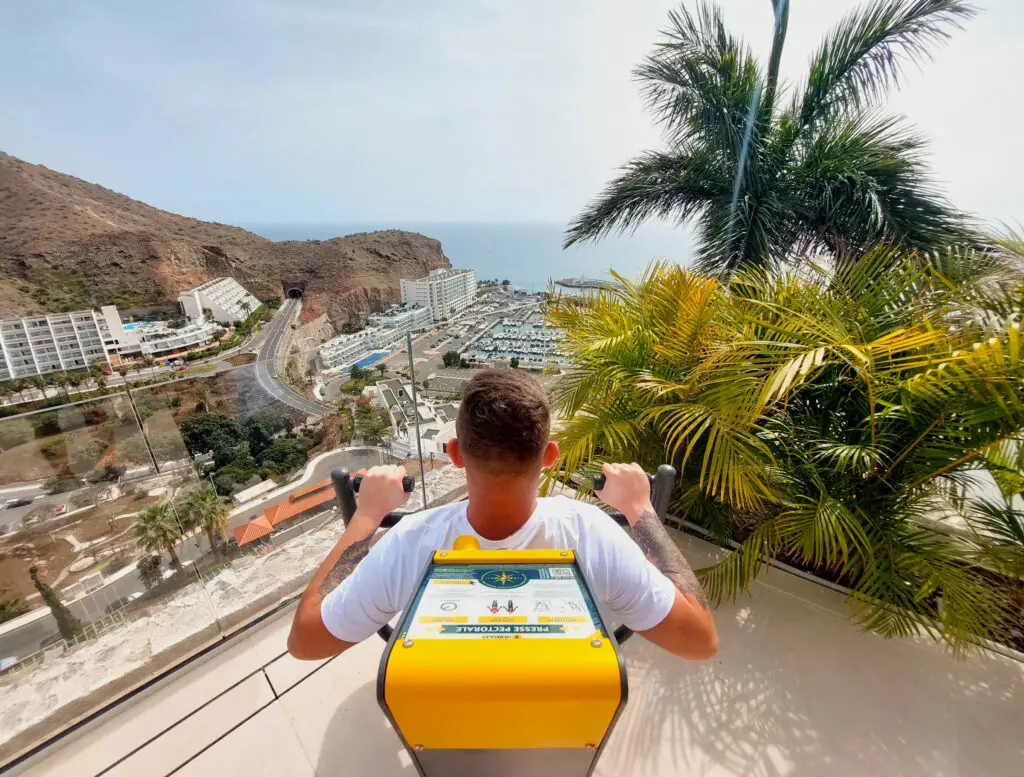
Three examples of sessions using our equipment to train safely during the heatwave
It’s perfectly possible to train safely in very hot weather, provided you adapt your exercise routine and choose the right equipment. Herkules equipment is designed not only for intensive outdoor use, but also to guarantee optimum comfort even in the hottest weather. Here are three practical ways to keep moving with peace of mind.
Session 1: Mobility and gentle strengthening (30 minutes)
Objective: activate the body gently, without excessive temperature rise
These machines combine light strengthening movements with joint work. The Leg Stretch, for example, promotes flexibility without cardio stress, while the Surfeur provides a fluid upper-body workout. By combining fixed and mobile stations, this session provides a safe workout even for inexperienced exercisers.
Session 2: Moderate, short, controlled HIIT (15-20 minutes)
Objective: maintain cardio and muscle tone without overheating
The elliptical trainer provides smooth, progressive exercise with good ventilation. The Abdos Bench provides sheathing work adapted to the heat, without prolonged support on the floor. This format enables you to train in complete safety, thanks to its short duration, controlled intensity and active recovery.
Session 3: Paired evening circuit (30 to 40 minutes)
Objective: keep the two of you motivated while respecting the limits imposed by the heat.
The apparatus selected here alternate duet exercises with breaks and mobility. The Pas Japonais adds a playful dimension and balance, while the Twister stimulates the obliques without excessive intensity. Thanks to a dynamic alternation between action and recovery, everyone can train in complete safety, in a friendly, controlled atmosphere.
Is it ever necessary to give up safe training?
Even with all the right reflexes and the best equipment, there are situations where training in complete safety is simply no longer possible. During extreme heatwaves, certain climatic conditions can make any outdoor physical activity risky, whatever the level or preparation of the participant.
When temperatures exceed 35°C in the shade and humidity levels are very high, the body’s ability to regulate its temperature becomes insufficient. Perspiration evaporates poorly, the body becomes dehydrated more quickly, and the risk of heat stroke increases sharply. In such cases, even a gentle or shortened session is no longer a viable option.
Safe training also means listening to your body and accepting a break when conditions demand it. It’s not a question of giving up, but of postponing or replacing the session with a more suitable alternative: a quiet walk in the shade, an indoor mobility session, or simply active rest.
For local authorities, it’s also important to communicate clearly with users in the event of a heatwave alert. Temporarily closing access to certain facilities or displaying visible recommendations are among the best practices to ensure that everyone can train safely… or decide not to train at all, without feeling guilty.
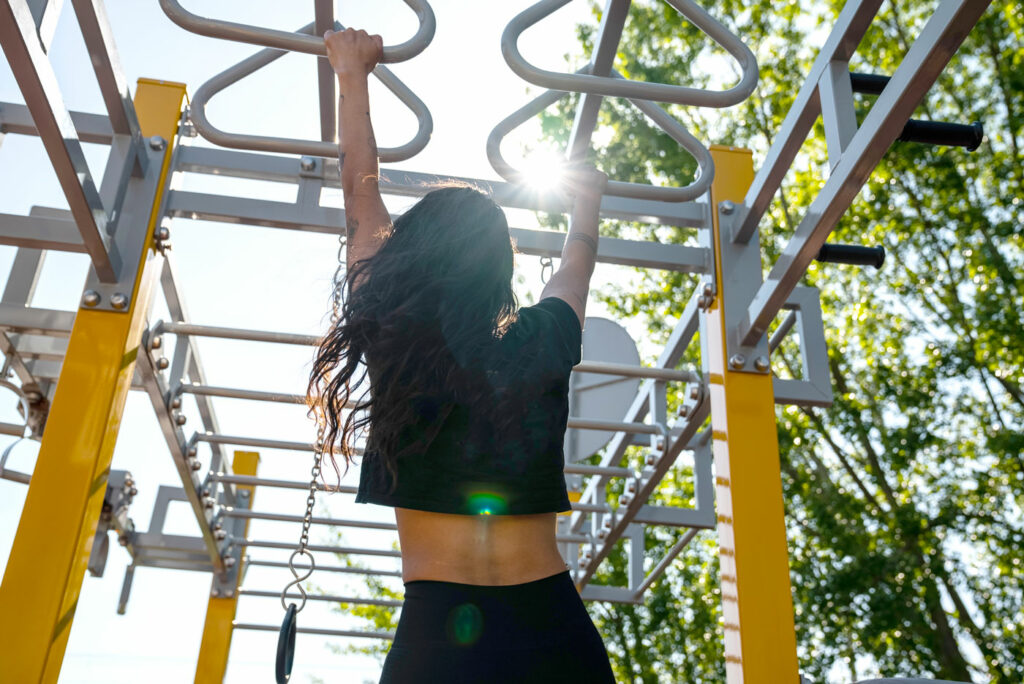
Conclusion
Outdoor fitness remains a great way to maintain regular physical activity, even during the summer months. However, heatwaves call for particular vigilance. It’s not enough to keep on working out at all costs: you need to adapt your habits, schedules, equipment and intensity to ensure that each session remains beneficial and safe.
Training safely in hot weather is above all a matter of common sense. By applying a few simple principles: hydration, shade, adapted equipment, lighter sessions, everyone can continue to take care of their body while respecting their limits.
Local authorities also have an essential role to play. By providing well-designed, shaded and ventilated outdoor fitness areas for all ages, they help to make physical activity accessible in all seasons.
At Herkules Fitness, we believe that safe training should never be a constraint, but a necessity. That’s why our equipment is designed to meet the demands of the climate, the diversity of users and the realities of the terrain. In summer, more than ever, outdoor sports can remain a pleasure… as long as you stay in tune with yourself and your environment.

